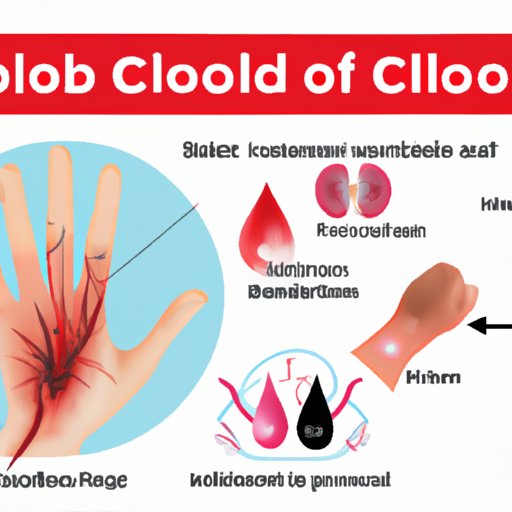I. Introduction
Blood clots can form anywhere in the body and are potentially life-threatening if left untreated. They can cause stroke, heart attack, and deep vein thrombosis. It’s crucial to recognize the symptoms of a blood clot and seek medical attention right away.
This article is for anyone who wants to learn about the common signs of a blood clot and the factors that increase its risk. Here, we will describe the symptoms of a blood clot, common causes, prevention strategies, and more.
II. 10 Common Signs of a Blood Clot You Should Not Ignore
Some people with blood clots experience no symptoms, while others exhibit one or more of the 10 common signs listed below:
1. Swelling in the arm or leg.
2. Redness or discoloration on the affected area.
3. Pain or tenderness in the affected area, especially when standing or walking.
4. Warmth and heaviness in the affected area.
5. Shortness of breath or difficulty breathing.
6. Racing heartbeat and chest pain.
7. Coughing up blood or pinkish mucus.
8. Dizziness or fainting.
9. Abdominal pain, nausea, or vomiting.
10. Sudden severe headache, double vision, or blurry vision.
If you experience any of these symptoms for an extended period, you should see a doctor immediately. Blood clots require aggressive intervention to prevent dangerous complications like stroke or pulmonary embolism.
III. How to Identify a Blood Clot – Symptoms and Causes
Some of the most common and easily identifiable symptoms of a blood clot include leg swelling, redness or discoloration on the affected area, warmth, and tenderness. Blood clots also occur in other areas of the body, including the lungs, brain, and abdomen. Symptoms of a heart attack or stroke may indicate a blood clot blocking blood flow in a vessel.
Several factors increase the risk of blood clots, including obesity, prolonged bed rest, surgery, and injury. Long air or car travel and smoking can also increase the risk of blood clots.
IV. A Comprehensive Guide to the Symptoms of Blood Clotting Disorders
Blood clotting disorders are medical conditions that increase the risk of developing blood clots. These disorders include deep vein thrombosis, pulmonary embolism, Factor V Leiden, and others.
The symptoms of blood clotting disorders vary depending on the type of condition, and they can range from mild to severe. For example, people with deep vein thrombosis may experience symptoms such as swelling, redness, warmth, and leg pain.
If you have a blood clotting disorder, your doctor may prescribe medications to prevent clots from forming or growing. You may also need to make lifestyle changes, such as losing weight, quitting smoking, or eating a healthy diet.
V. Recognizing the Early Warning Signs of Blood Clots to Prevent Complications
Blood clots can cause severe complications if left untreated. For this reason, early detection is vital. Some less common symptoms to watch out for include sudden onset of shortness of breath, coughing up blood, sudden severe headache, and chest pain.
If you experience any of these symptoms, consult your doctor right away. Prompt treatment can help prevent complications such as heart attacks, strokes, or pulmonary embolism.
VI. The Top 5 Symptoms of a Blood Clot and What You Can Do About It
Even though blood clots can present in different parts of the body, some common symptoms are shared. Here are the top five symptoms you should look for:
1. Swelling in the legs or arms
2. Pain or tenderness especially when standing or walking
3. Worsening leg pain when bending the foot
4. A warm or reddish leg
5. Abnormal symptoms in the chest such as cough, shortness of breath and chest pain.
If you experience any of these symptoms, see your doctor immediately. In addition to medical intervention, you need to make relevant lifestyle changes such as drinking plenty of water, regular exercise, quitting smoking, and avoiding certain medications.
VII. Blood Clot Symptoms – What You Need to Recognize and Respond
If you suspect you have a blood clot, here’s what you should and should not do:
1. Do not rub or massage the affected area.
2. Do not continue to stand or sit for prolonged periods.
3. Seek immediate medical attention.
4. To prevent blood clots, move around regularly during long trips.
5. Maintain a healthy weight and keep active.
To help prevent blood clots, you must take effective measures to stay healthy, such as:
1. Getting regular exercise
2. Maintaining a healthy diet and weight
3. Quitting smoking
4. Limiting alcohol intake
5. Taking prescribed medication.
VIII. The Tell-Tale Signs of a Blood Clot – How to Stay Safe and Healthy
Blood clots can be challenging to spot, as not everyone with a blood clot exhibits symptoms. However, there are several strategies you can use to minimize the likelihood of clots, including:
1. Stay active
2. Maintain a healthy body weight
3. Drink plenty of water
4. Take breaks when sitting for prolonged periods
5. Use compression stockings.
It would also be best if you spoke to your doctor to create a management plan for reducing the risk of future blood clots.
IX. Conclusion
Blood clots require immediate medical intervention. In the absence of treatment, blood clots can lead to severe complications, including stroke, heart attack, and deep vein thrombosis. It’s essential to look for early warning signs and receive prompt medical attention.
The earlier you detect a blood clot, the better your chances of preventing severe complications. If you are in doubt, do not hesitate to seek medical advice. Remember to stay healthy by maintaining a healthy body weight, keeping active, drinking plenty of water, and avoiding long periods of sitting.
